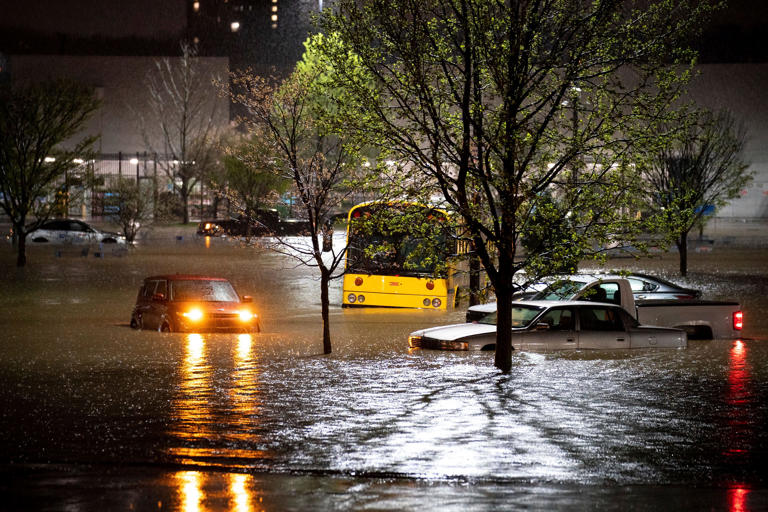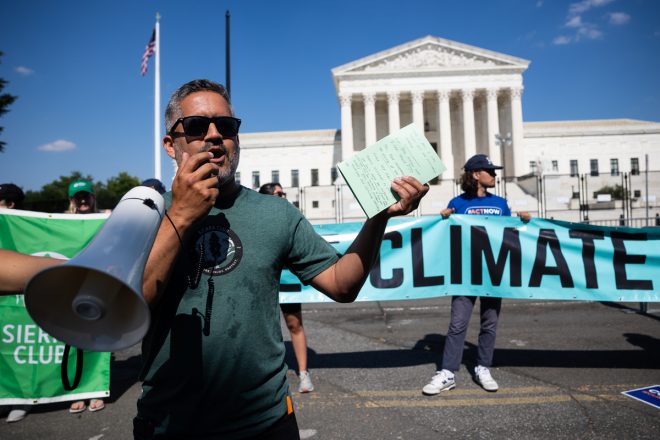In a 6-3 decision Thursday, the U.S. Supreme Court’s conservative bloc significantly limited the ability of the Environmental Protection Agency to address climate change, experts say. But the decision could have even wider implications.
The ruling marks a major inflection point in two key storylines. Groups pushing for more robust action on climate, which scientists warn is needed to ward off a collection of global catastrophes ahead, say the decision handicaps the federal government’s ability to regulate greenhouse gas emissions from the U.S. energy sector, the second largest contributor of such pollutants after transportation.
“It strips federal EPA scientists of their ability to help the American public tackle the worst effects of climate change, and the EPA of its power to protect the environment and our communities from a worsening climate crisis,” said Marie Owens Powell, president of AFGE Council 238, the EPA’s largest employees union.
But also, the ruling could create a “massive chilling effect” for regulators at a wide variety of federal agencies, from the Department of Transportation, to the Department of Energy, to the Occupational Health and Safety Administration, said Kevin Bell, staff counsel for the environmental nonprofit Public Employees for Environmental Responsibility.
“Any major regulatory program that involves a shift away from current practices … is now going to face big problems,” Bell predicted.
Here are the details, according a variety of past and present EPA employees and legal experts from across the political spectrum:
What is West Virginia v. EPA about?
On its face, the scope of West Virginia v. EPA appears somewhat limited. The majority opinion authored by Chief Justice John Roberts, Jr. puts the final nail in the coffin for the EPA’s Clean Power Plan. That Obama-era regulation sought to forcefully transition the nation’s energy supply away from coal and natural gas power plants and toward renewable energy sources like wind and solar. The goal was to substantially reduce emissions of greenhouse gases like carbon dioxide, cutting down on U.S. contributions to global warming.

But finalized in 2015 toward the end of Obama’s second term, the rule never got off the ground. Opponents sued before the Trump administration rolled it back in 2017, then replaced it with an alternative Affordable Clean Energy rule. That plan too was taken to court, with both ultimately ending up before the Supreme Court in West Virginia.
More recently, the Biden administration said it intended to scrap both plans regardless of the court’s decision and work toward a new one. In that way, there was little immediate impact from the court’s decision Thursday.
And the goals of the Clean Power Plan have already been achieved.
Eric Schaeffer, executive director of the nonprofit Environmental Integrity Project and a former EPA enforcement chief, noted the EPA calculated the Clean Power Plan would cut coal power to 27% of the nation’s energy supply by 2030. But the U.S. Energy Information Administration notes it had already dropped to 21.8% last year.
So what’s the big deal?
Despite progress in the energy sector, scientists and environmental groups warn that the climate picture has worsened since 2015. Even with the unexpected drop in coal and rise in renewables, the U.S. is still not on track to meet its climate goals of cutting greenhouse gas emissions in half by 2030.
“Progress is faster than was anticipated, but the problem is also worse than we thought it was,” said David Doniger, a senior strategic director for the Natural Resources Defense Council. “We need to go further and faster.”

Doniger and other environmental advocates say that means the federal government still needs to do more to address climate change. And the EPA is poised to do so: A 2007 Supreme Court ruling in Massachusetts v. EPA found that the agency does in fact have the authority to regulate greenhouse gases like carbon dioxide.
The EPA is also the primary federal agency with the authority to tackle air pollutants and environmental issues. Advocates were hopeful a new plan under Biden could further speed the nation’s energy transition, but Nicole Cantello, an enforcement attorney for the EPA’s regional offices in Chicago, said Thursday’s ruling is a significant setback.
“There is no time to waste … and now we feel like time is passing us by to regulate this,” said Cantello.
So how does West Virginia v. EPA restrict climate action?
Thursday’s decision does not overturn the 2007 precedent and in fact leaves the EPA’s ability to regulate carbon dioxide in place.
“The Supreme Court didn’t say you couldn’t regulate … or that there was nothing that can be done,” said Allison Wood, an attorney for the Virginia-based law firm McGuireWoods.
But, legal experts say, it substantially limits the EPA’s ability to do so.
For many air pollutants, the EPA requires filters or “scrubbers” to be installed on industrial facilities to remove harmful chemicals from the air. Such regulations, the conservative majority ruled, are well established and can be used. But justices said the EPA overstepped its authority by creating a plan that would force a nationwide energy transition, an effect too “major” to occur without explicit permission from Congress.
“The basic and consequential trade-offs involved in such a choice are ones that Congress would likely have intended for itself,” Roberts wrote. “Congress certainly has not conferred a like authority upon EPA anywhere else in the Clean Air Act.”
Environmental groups say the ruling creates a Catch-22 that essentially kills the agency’s ability to combat greenhouse gas emissions from power plants anyway. Filtration technologies are not currently robust enough to adequately stop the emission of carbon dioxide and other gasses from coal and natural gas power plants, they say.
But if the agency tries to come up with another, newer method, it risks being struck down by the court again due to the scope of the problem.
“It’s going to make it very, very hard to regulate climate change in the future,” said Jonathan Masur, a professor of law at the University of Chicago.
What about other environmental regulations?
As the court’s decision on the case approached, some environmental groups worried it would go even further, striking down any regulation not explicitly authorized by Congress. That didn’t happen, but the court’s intervention based on the regulation being too “major” will have a similar effect anyway, some argue.
Traditionally, the EPA and other federal agencies have had significant freedom to create regulations they felt addressed the nation’s challenges. For example, Congress in the 1970s created the Clean Water Act and Clean Air Act to address rampant nationwide pollution, leaving it to the EPA to create the rules and regulations to clean it up.
The Supreme Court Thursday essentially ruled the EPA had overstepped its Clean Air Act authority. But the same principle could be applied to regulations under the Clean Water Act. Or to the regulations of other federal agencies, Masur said. He pointed out that the court already restrained OSHA this year, when it ruled that its regulation mandating workers of large companies to either receive a COVID-19 vaccine or wear a mask overstepped its authority to create safe workspaces.
Some legal experts argue that without a clear definition of what makes a regulation “major” enough to overstep its authority in the eyes of the Supreme Court, regulators of any agency will face a chilling effect as they attempt to renew or create regulations.
“Whenever EPA is trying to regulate something either very politically sensitive or economically significant … then it can only do so if it has clear, explicit statutory authority from Congress,” Masur said.
However, others doubt the West Virginia ruling will have that substantial of an effect.
Stan Meiburg, a former deputy administrator at EPA under the Obama administration, said the West Virginia case largely hinged on a subsection of the Clean Air Act agency employees have long known could be problematic. While he still believes the Supreme Court’s decision unduly handicaps the agency, other programs with better precedent, such as those used to increase the fuel efficiency of cars, are more likely to survive, he believes.
“There will be a chilling effect … but how much of an effect is hard to say,” Meiburg said.
What’s next?
Policy experts say there are a range of possibilities stemming from the West Virginia decision.
To tackle climate change, the EPA may go ahead with new plans to reduce emissions from the energy sector — a step some environmental groups are urging, despite another potential legal challenge.
“EPA needs to get its proposal to revise carbon limits for power plants out for public review as soon as possible,” said Schaeffer of the Environmental Integrity Project.
Or the agency could work to fight greenhouse gas emissions in other ways. Schaeffer said the agency can implement more time-tested regulations on other harmful emissions from power plants that would also curb coal production. Others argue the EPA now has explicit approval to require coal and natural gas plants to install the latest generation of carbon-capturing equipment, or that the agency could focus on other greenhouse gasses like methane, which can leak from gas wells and landfills.
Others say it may be time to start looking for solutions outside the federal government.
Wood, the Virginia-based attorney who has represented the interests of industrial clients in federal cases, said she hopes the decision will result in environmental groups looking away from the EPA and toward working with corporations to improve environmental practices.
“There are ways of getting at it through companies themselves,” Wood said.
Meiburg, the former EPA deputy administrator, noted the Clean Air Act and Clean Water Act are decades old. With Congress deadlocked and unable to pass new legislation, and the court’s conservative supermajority disinclined to allow EPA and other agencies to meet new challenges, there’s not much recipe for success.
Instead, Meiburg believes significant victories could be won by focusing on state policies. In North Carolina, a Republican-controlled legislature worked with the state’s Democratic governor to create a goal of 70% greenhouse gas reduction by 2030, he noted.
“I think the (Supreme Court decision) takes away a tool that could have been very helpful,” Meiburg said. “But it didn’t take away every tool.”





































